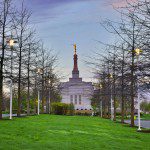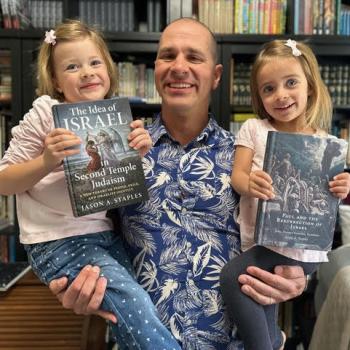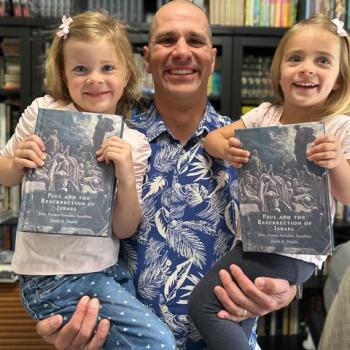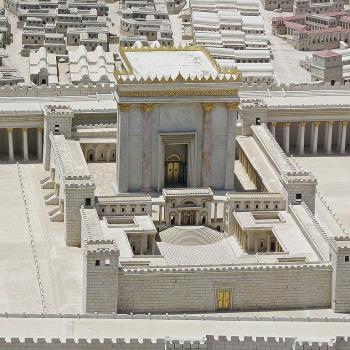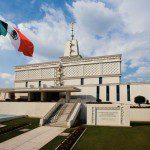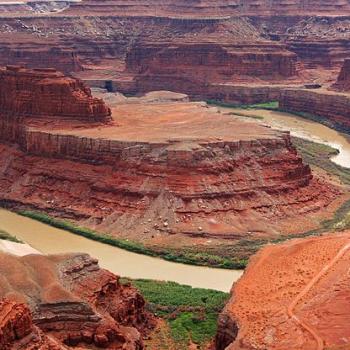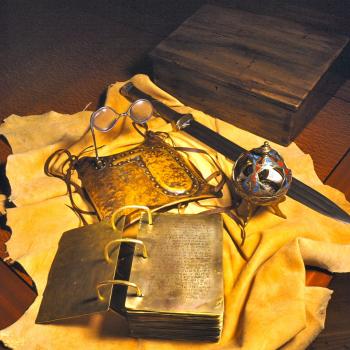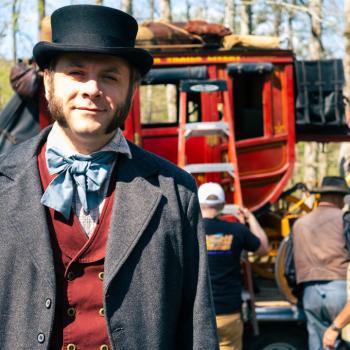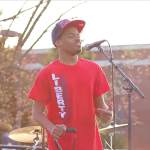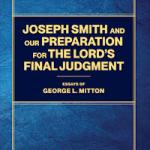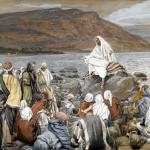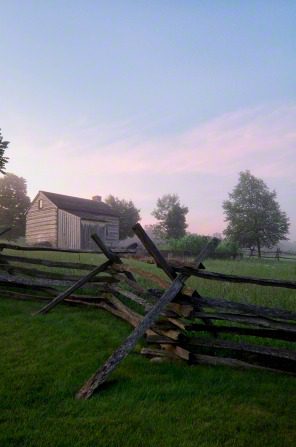
(Image from LDS Media Library)
It has been a fairly long day. I’m back here with a film crew from Scripture Central who are working on an episode in their series A Marvelous Work. The series is hosted by Scott Christopher (who, by the way, played Peter Whitmer Sr. in the Interpreter Foundation films Witnesses and Undaunted: Witnesses of the Book of Mormon). We spent the morning filming atop the Hill Cumorah, where we happened to run into a group of new hires in BYU Religious Education. I knew several of them, and they were led by their dean, Scott Esplin, who has been a supportive ally of Interpreter’s filmmaking (and was so again today). A little bit later, a young couple came up who are the in-laws of my nephew. They were making a weekend trip from their home in Virginia. They recognized me, and we had a pleasant conversation.
In the afternoon, we spent our our time on the Smith Family Farm — in their family’s log home, where I was interviewed on camera, and then in their larger frame home, where Casey Griffiths (who was operating for part of the day with a separate filmmaking crew) and I were interviewed together.
Meanwhile, the Interpreter Foundation’s own film crew has been working away down in Tennessee. Apparently, it’s been raining down there today. And, up here, we too were obliged to deal with a pretty constant but seldom very heavy rain. Happily, filming went quite well nonetheless.
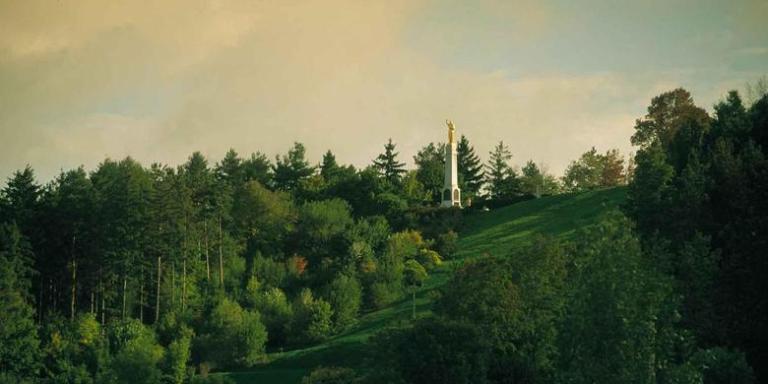
I received the following note today from Gregory Dundas, and I’m delighted to pass it on to you:
Hey friends!!
I hope this finds you well.
Just a quick notice to let you know that my new book is out!
It’s entitled “Mormon’s Record: The Historical Message of the Book of Mormon.” It’s being published jointly by the Brigham Young University Religious Studies Center (RSC) and Deseret Book, and is currently available on Amazon, Deseret Book, and the RSC websites.If the title sounds intriguing to you, click on the link below for a 1-page blurb about the book.And if you’d be interested in watching a podcast where I discuss the book, my purposes in writing it, etc., you can find it here: https://www.youtube.com/watch?v=YWgSFlWRHzMAnd if you know of anyone (friends, family) that you think might be interested, please let them know!As always, if you have any reactions to the book, don’t be shy about letting me know what you think – I love receiving feedback!Thanks so much for all your support!Please be well!
Here is a précis of the book, to which I’m really looking forward:
Mormon’s Record: the Historical Message of the Book of Mormon
What is the Book of Mormon, and what is it about?
First and foremost it is a history—a sacred history with a message that taps into one of the most perennial and compelling themes of historiography, the rise and fall of civilization. As such, it deserves to be taken seriously as a prophet-historian’s visionary effort to say something of vital importance as he witnessed his own nation collapsing in utter ruin around him.
Mormon’s Record show us how the full nature and significance of Mormon’s history becomes clear only if approached from the perspective of ancient historical writing with its rigorous moral worldview and its regard for the role of Deity in human history. The sobering message of Mormon’s record—the devastating impact of contention and civil conflict on the fabric of society—is shown to emerge from its supporting historical narrative. At the same time, this grim lesson is balanced with the reassuring message of the gospel of Jesus Christ: the power of repentance and forgiveness.
Hugh Nibley once wrote: “For some reason there has been chosen for our attention a story of how and why two previous civilizations on this continent were utterly destroyed.”
More recently, President Nelson declared: “The Book of Mormon chronicles the classic rise and fall of two major civilizations. Their history demonstrates how easy it is for a majority of the people to forget God, reject warnings of the Lord’s prophets, and seek power, popularity, and pleasures of the flesh.”
And President Ezra Taft Benson said, “The Book of Mormon . . . is a record of a fallen people, compiled by inspired men for our blessing today.”
So the question is, how does the record of a fallen people bless us today? And why did Mormon go to so much trouble to write this long and detailed history of his people, and why did the Lord go to so much trouble to bring it to our attention today? And why, out of the 239 total chapters of the Book of Mormon, do 174 of them deal with such unpleasant subjects as contention, war, assassination, conspiracy, and so on?
This illuminating, in-depth study of Mormon’s historical opus highlights the prophetic timeliness of his message from antiquity tailored explicitly for the modern world.
Another brief account of the book runs as follows:
Although the ancient scriptural record known as the Book of Mormon contains profound doctrinal and theological content, it is foremost a history. Thus, it is not surprising that it has the earmarks of ancient rather than modern works of history. Yet few studies analyze the Book of Mormon as a legitimate work of ancient history. The author describes the sacral worldview that informed much of ancient writing, surveys four millennia of historical writings to show how the sacral worldview differs from modern historiography, and discusses many underlying historical themes found in the writings of Israelite and Greco-Roman historians that also figure in the composition of the Book of Mormon. That scripture’s sobering theological message is shown to emerge from the historical accounts that inform it.
Brother Dundas has impressive credentials:
Gregory Steven Dundas received his PhD in Greek and Roman history from UCLA, a BA in history and classics from San Diego State University, and a JD from the University of Michigan Law School. He is the author of Explaining Mormonism: A Believing Skeptic’s Guide to the Latter-day Saint Worldview (2022). For several years he taught classes in history and classics and then went on to work for two decades as an attorney with the U.S. Securities and Exchange Commission. He now pursues his passion for studying and writing about ancient cultures, especially ancient religious worldviews. He and his wife, Macedonia, have two sons.
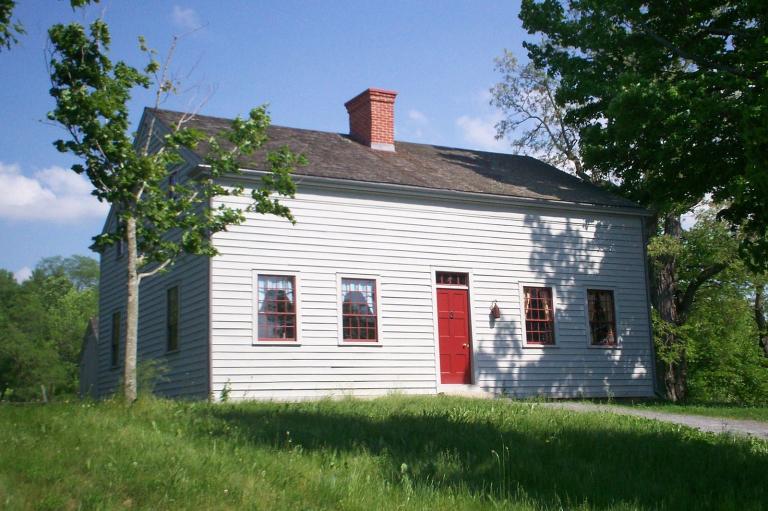
(Wikimedia Commons public domain image)
I think, too, that some of you might be interested in a new limited series podcast that deals with the complicated case of Chad Daybell and his curious beliefs. It’s a nine-episode arc on Angels and Seerstones: A Latter-day Saint Folklore Podcast. Christopher Blythe (who, incidentally, wrote the most downloaded article in the history of Interpreter: A Journal of Latter-day Saint Faith and Scholarship) tells me that he thinks it might, at the moment, be the only sustained treatment of Daybell by a Latter-day Saint. The fourth episode drops on Wednesday.
Posted from Rochester, New York



